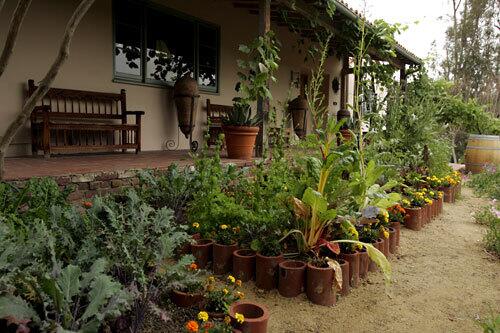Most Read in This Section
-
-
-
-
Nov. 8, 2024

Robin Stever had long dreamed about owning a vineyard, and lo and behold, one day she returned to her

Barrantes learned to drive a Bobcat and graded some of the lot himself. With a friend and several helpers, they built a series of retaining walls using broken concrete scavenged from a nearby road resurfacing job and local building projects. The walls were dry-stacked, meaning no cement or rebar was used. Barrantes estimates that he and his crew constructed more than 1,000 feet of wall during two summers. Stevers joked that her son, who is part Peruvian, was building his Machu Picchu. (Gary Friedman / Los Angeles Times)

A small fountain unearthed and saved during grading. (Gary Friedman / Los Angeles Times)

Rocks were dragged into place to create a small waterfall and ponds, edged by a tangle of nasturtium, alstroemeria, mint and rosemary. (Gary Friedman / Los Angeles Times)

Primrose blossoms in front of the waterfall. (Gary Friedman / Los Angeles Times)

A dry arroyo, designed as a visual extension of the ponds, is used to carry the runoff to the rancho’s latest addition, an orchard planted with plum, cherimoya, guava, nectarine and apple trees. (Gary Friedman / Los Angeles Times)

Barrantes continued to work on his parents’ suburban rancho for years, plowing profits from his sustainable landscape design firm, La Loma Development Co., into the project. He added an assortment of edible, native, Mediterranean and drought-tolerant plants. Runaway zucchini vines curl around a neighboring agave, and blueberry bushes edge pathways, the first crop ready for picking this summer. A desert garden, filled with beavertail cactus, blue aloe and aeonium, plays host to pomegranate trees. Otherworldly-looking artichoke plants with spiky purple blossoms and jagged-edge silvery leaves self-seed and pop up randomly. “I’m not a boxwood kind of person,” Stevers says. (Gary Friedman / Los Angeles Times)

The blossom of a Jerusalem artichoke. (Gary Friedman / Los Angeles Times)

Tile drain pipes from the 1930s, which Marco found while digging at his own home nearby, were repurposed as planters for strawberries, chard, eggplant, lettuce and peppers. (Gary Friedman / Los Angeles Times)

Drain pipes as rustic planters. (Gary Friedman / Los Angeles Times)

What had been a steep slope “with a very ordinary, very ugly lawn,” Stevers says, became a terraced vineyard with more than 70 Zinfandel vines. Planted in 2005, the grapes grow from 7-foot-tall trellises to catch the breezes and make grapes easier to eat off the vine, Barrantes says. More artichokes blossom underneath the vines. (Gary Friedman / Los Angeles Times)

“We knew the grapes would grow well here in this climate,” Barrantes says. He had the area’s history as a guide too: A small lake across the street had been the site of the former San Rafael Winery, established in 1875. Rancho La Loma vineyard had its first crush in 2008 with the help of a grandfatherly Italian acquaintence who made wine the old-fashioned way with hand-operated equipment. Aged for six months in glass 5-gallon drums, that first crush produced 100 gallons of wine, which Marco describes as “young and fruity, a great Sangria mix.” Says his mom: “It’s not very good, but Marco likes it.” (Gary Friedman / Los Angeles Times)

The purple flower of an artichoke plant. (Gary Friedman / Los Angeles Times)

Peruvian lanterns hang from a coast live oak. For Stevers, the evolution of the landscape is all about wish fulfillment. She says simply: “I’m very happy in it.” (Gary Friedman / Los Angeles Times)

Barrantes set up an amusing “rescue center,” where unused plants can be rehabilitated and donated to schools. He calls working on his parents’ garden “life changing.” What started as a small-scale attempt at self-sufficiency has set the direction for his career and business. But perhaps just important to Marco, a fifth-generation Pasadenan, is a sense of history and heritage. With an eye to the future, he says, “I’ll see my grandchildren here one day.”
Want to peruse more gorgeous gardens? Check out our garden tour gallery. (Gary Friedman / Los Angeles Times)
Nov. 8, 2024